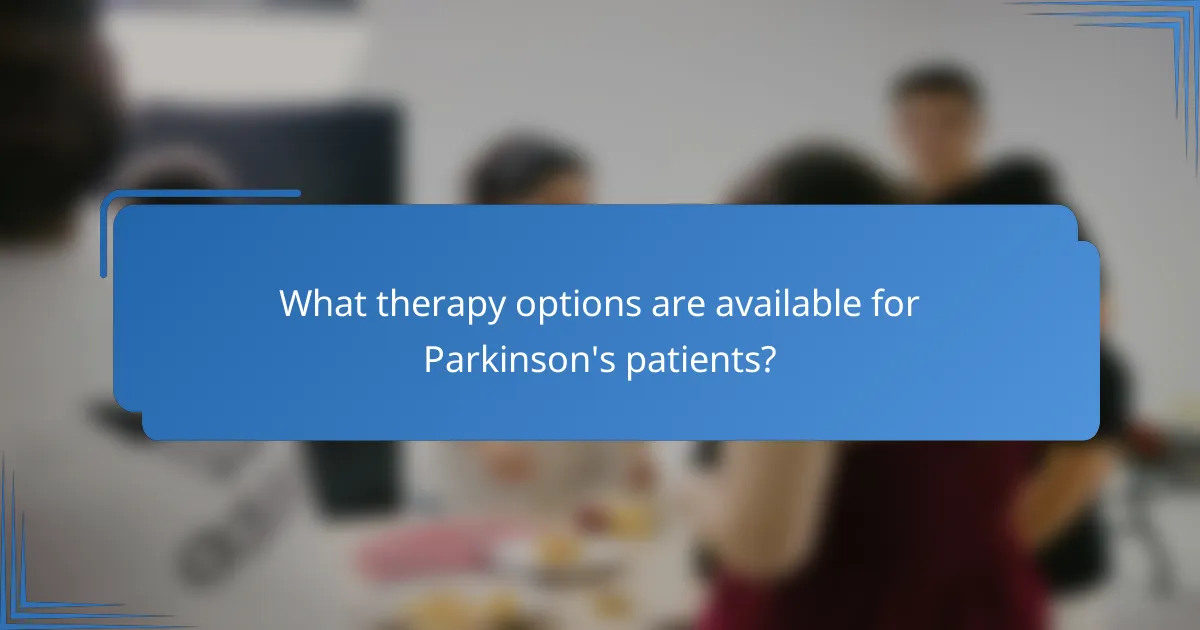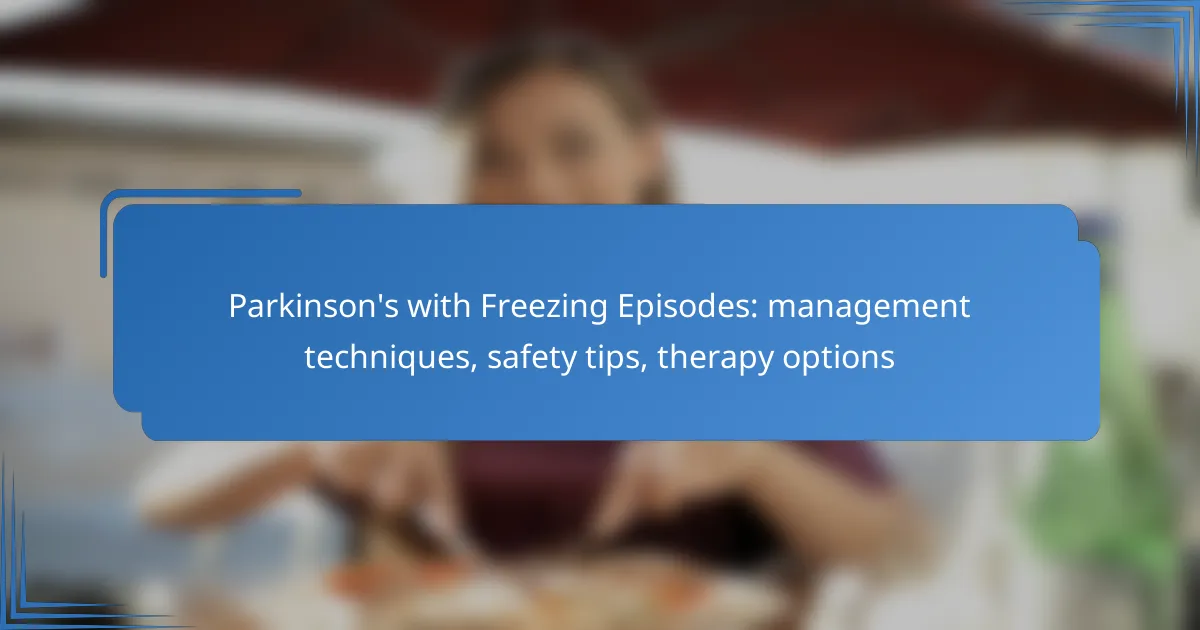Managing Parkinson’s disease with freezing episodes requires a multifaceted approach that includes therapy, medication adjustments, and assistive devices to enhance mobility and safety. Creating a supportive environment and having clear safety plans can significantly reduce fall risks, allowing individuals to move more confidently. Additionally, exploring various therapy options, such as deep brain stimulation and complementary therapies, can further improve quality of life for those affected.

What are effective management techniques for Parkinson’s with freezing episodes?
Effective management techniques for Parkinson’s with freezing episodes include a combination of therapies, medication adjustments, and the use of assistive devices. These strategies aim to improve mobility, enhance safety, and reduce the frequency of freezing episodes.
Physical therapy
Physical therapy focuses on improving movement and coordination for individuals experiencing freezing episodes. Therapists may employ techniques such as gait training, balance exercises, and strength conditioning to enhance mobility and reduce the risk of falls.
Incorporating regular physical activity, such as walking or stretching, can help maintain flexibility and strength. Patients should aim for at least 150 minutes of moderate exercise weekly, as recommended by health guidelines.
Occupational therapy
Occupational therapy assists individuals in adapting their daily activities to minimize freezing episodes. Therapists work with patients to develop strategies for tasks such as dressing, cooking, and managing personal care, making these activities easier and safer.
Techniques may include breaking tasks into smaller steps, using visual cues, or modifying the environment to reduce distractions. Patients can benefit from creating a structured routine to enhance predictability and reduce anxiety during tasks.
Speech therapy
Speech therapy can address communication challenges and swallowing difficulties often associated with Parkinson’s. Therapists may teach techniques to improve voice volume and clarity, which can be particularly beneficial during freezing episodes when stress can exacerbate symptoms.
Practicing specific vocal exercises and using strategies like pacing speech can help maintain effective communication. Patients should engage in regular sessions to reinforce these skills and build confidence in their speaking abilities.
Medication adjustments
Medication adjustments can play a crucial role in managing freezing episodes in Parkinson’s patients. Doctors may evaluate current medications and modify dosages or introduce new drugs to optimize symptom control.
Common medications include dopaminergic agents, which can help improve motor function. Regular follow-ups with a healthcare provider are essential to monitor effectiveness and adjust treatment plans as needed.
Assistive devices
Assistive devices can enhance safety and mobility for individuals with Parkinson’s experiencing freezing episodes. Tools such as walking aids, grab bars, and non-slip mats can help prevent falls and provide support during movement.
Patients should consider using a cane or walker, especially in unfamiliar or crowded environments. It’s important to choose devices that are comfortable and easy to use, ensuring they are integrated into daily life for maximum benefit.

How can safety be ensured during freezing episodes?
Ensuring safety during freezing episodes involves creating a supportive environment and having clear plans in place. This can significantly reduce the risk of falls and injuries, allowing individuals to navigate their surroundings more confidently.
Home modifications
Making specific modifications to the home can enhance safety for individuals experiencing freezing episodes. Consider removing tripping hazards like loose rugs and clutter, and ensure that pathways are clear. Installing grab bars in bathrooms and using non-slip mats can also provide additional support.
Lighting is crucial; ensure that all areas are well-lit, particularly staircases and hallways. Motion-sensor lights can be beneficial, as they automatically illuminate spaces when someone approaches, reducing the risk of freezing in dark areas.
Emergency plans
Establishing an emergency plan is vital for managing freezing episodes effectively. This plan should include clear steps to take when a freezing episode occurs, such as sitting down in a safe location until the episode passes. Informing family members or caregivers about these steps can ensure a quick response when needed.
Consider creating a communication system, like a designated signal or phrase, to alert others when help is required. Regularly reviewing and practicing the emergency plan can help everyone involved feel more prepared and confident.
Wearable alert systems
Wearable alert systems can provide peace of mind for individuals experiencing freezing episodes. These devices can be programmed to alert caregivers or family members if a freezing episode occurs, allowing for timely assistance. Look for systems that are comfortable to wear and have a reliable battery life.
Some wearable devices also offer features like fall detection and GPS tracking, which can enhance safety further. When selecting a system, consider factors such as ease of use, connectivity options, and whether it integrates with other health monitoring devices.

What therapy options are available for Parkinson’s patients?
Parkinson’s patients can explore various therapy options to manage symptoms, including deep brain stimulation, transcranial magnetic stimulation, and complementary therapies. Each option has unique mechanisms and considerations that can help improve quality of life.
Deep brain stimulation
Deep brain stimulation (DBS) involves surgically implanting electrodes in specific brain areas to regulate abnormal impulses. This therapy can significantly reduce motor symptoms and improve daily functioning for many patients.
Before considering DBS, patients should consult with a neurologist to evaluate their suitability based on disease progression and overall health. The procedure may require ongoing adjustments and monitoring, which can be a commitment.
Transcranial magnetic stimulation
Transcranial magnetic stimulation (TMS) uses magnetic fields to stimulate nerve cells in the brain, potentially alleviating symptoms such as depression and motor dysfunction. TMS is non-invasive and typically requires multiple sessions for optimal results.
Patients should discuss TMS with their healthcare provider to determine if it fits their treatment plan. While generally safe, some may experience mild discomfort during the procedure.
Complementary therapies
Complementary therapies, such as physical therapy, occupational therapy, and speech therapy, can enhance traditional treatments for Parkinson’s. These therapies focus on improving mobility, daily living skills, and communication abilities.
Incorporating complementary therapies can provide a holistic approach to managing symptoms. Patients should work with their healthcare team to tailor a combination of therapies that best suits their individual needs and lifestyle.

What are the best practices for caregivers of patients with freezing episodes?
Caregivers of patients experiencing freezing episodes should prioritize understanding the condition and implementing effective management strategies. Key practices include training, connecting with support groups, and exploring respite care options to maintain both patient safety and caregiver well-being.
Training and education
Training and education are essential for caregivers to effectively manage freezing episodes in patients with Parkinson’s. Understanding the triggers and symptoms of freezing can help caregivers respond appropriately and reduce the frequency of episodes.
Consider enrolling in workshops or online courses focused on Parkinson’s disease and its complications. Many organizations offer resources that cover practical techniques for assisting patients during freezing episodes, such as using verbal cues or physical prompts to encourage movement.
Support groups
Support groups provide caregivers with emotional support and practical advice from others facing similar challenges. Engaging with a community can help alleviate feelings of isolation and provide valuable insights into managing freezing episodes.
Look for local or online support groups specifically for caregivers of Parkinson’s patients. These groups often share strategies, resources, and personal experiences that can enhance your caregiving skills and boost your confidence.
Respite care options
Respite care options are crucial for caregivers to take breaks and recharge while ensuring the patient remains safe. This type of care can be arranged through in-home services or short-term stays in specialized facilities.
Explore local respite care services that offer trained professionals who understand the needs of Parkinson’s patients. Many programs accept insurance or provide sliding scale fees, making them accessible for various budgets. Regular breaks can help prevent caregiver burnout and improve the overall quality of care provided.

How does Parkinson’s impact daily living in New Zealand?
Parkinson’s disease significantly affects daily living in New Zealand, particularly through symptoms like freezing episodes that can hinder mobility and independence. Individuals may experience challenges with movement, balance, and coordination, impacting their ability to perform everyday tasks safely.
Community resources
In New Zealand, various community resources support individuals with Parkinson’s disease. Organizations like Parkinson’s New Zealand provide information, support groups, and educational workshops tailored to help manage symptoms and improve quality of life.
Local community centers often host exercise classes specifically designed for people with Parkinson’s, focusing on improving mobility and reducing the risk of falls. Engaging with these resources can foster a sense of community and provide practical strategies for daily living.
Healthcare access
Accessing healthcare for Parkinson’s management in New Zealand typically involves consultations with general practitioners and neurologists who specialize in movement disorders. Patients may require regular check-ups to monitor their condition and adjust treatment plans as needed.
New Zealand’s public health system generally covers essential services, but waiting times for specialist appointments can vary. Patients are encouraged to explore private healthcare options if timely access is critical, especially for therapies that address freezing episodes and other symptoms.

What are the latest advancements in Parkinson’s treatment?
Recent advancements in Parkinson’s treatment focus on improving symptom management and enhancing quality of life for patients. Innovations in medication and therapy techniques are providing new hope for those experiencing challenges, including freezing episodes.
Research on new medications
Research is ongoing into new medications that target specific symptoms of Parkinson’s, particularly freezing episodes. Some promising candidates include drugs that enhance dopamine signaling or target other neurotransmitter systems to improve motor control.
Clinical trials are essential for evaluating the efficacy and safety of these new treatments. Patients are encouraged to discuss participation in trials with their healthcare providers, as this can provide access to cutting-edge therapies that may not yet be widely available.
Innovations in therapy techniques
Innovative therapy techniques are being developed to help manage freezing episodes in Parkinson’s patients. Techniques such as cueing strategies, where visual or auditory cues help initiate movement, have shown effectiveness in reducing freezing incidents.
Additionally, physical therapy and occupational therapy are being tailored to individual needs, focusing on exercises that enhance balance and mobility. Patients should work closely with therapists to create personalized plans that incorporate these techniques into daily routines.
